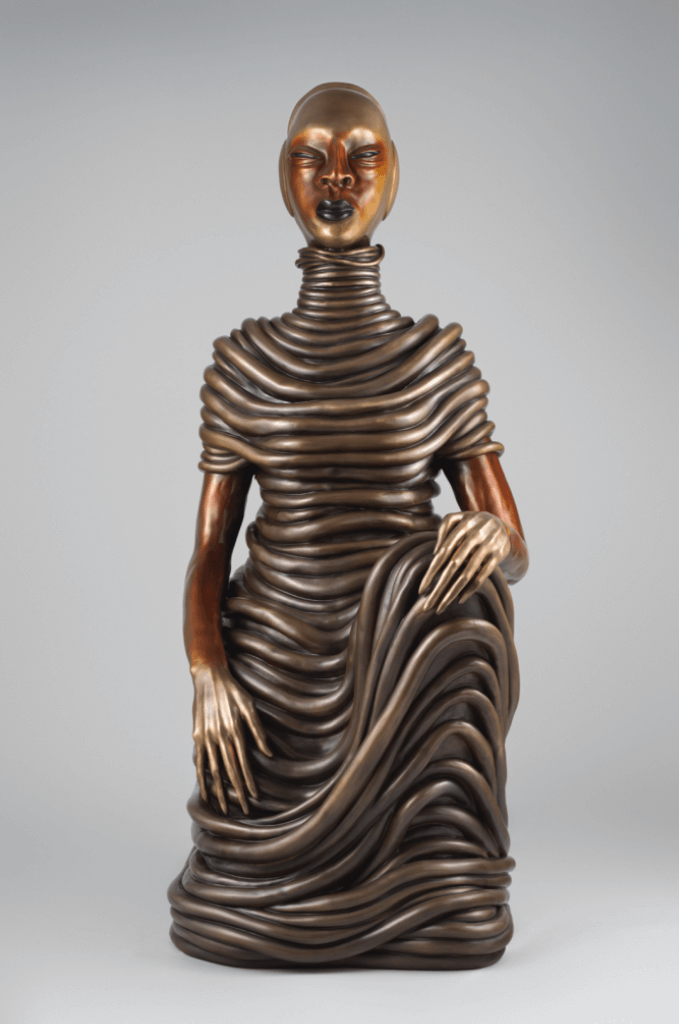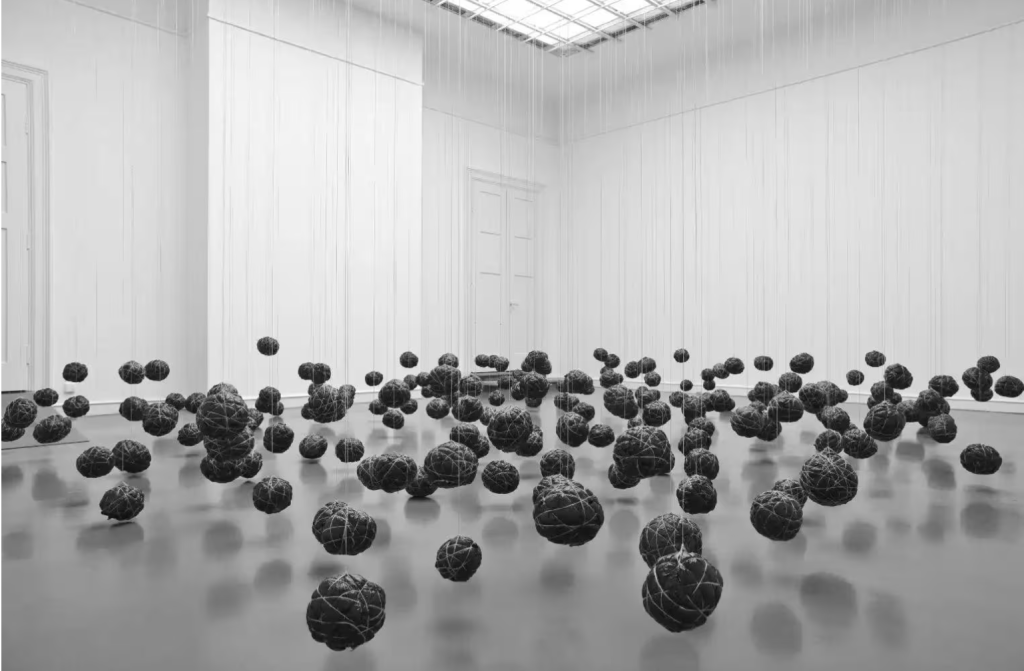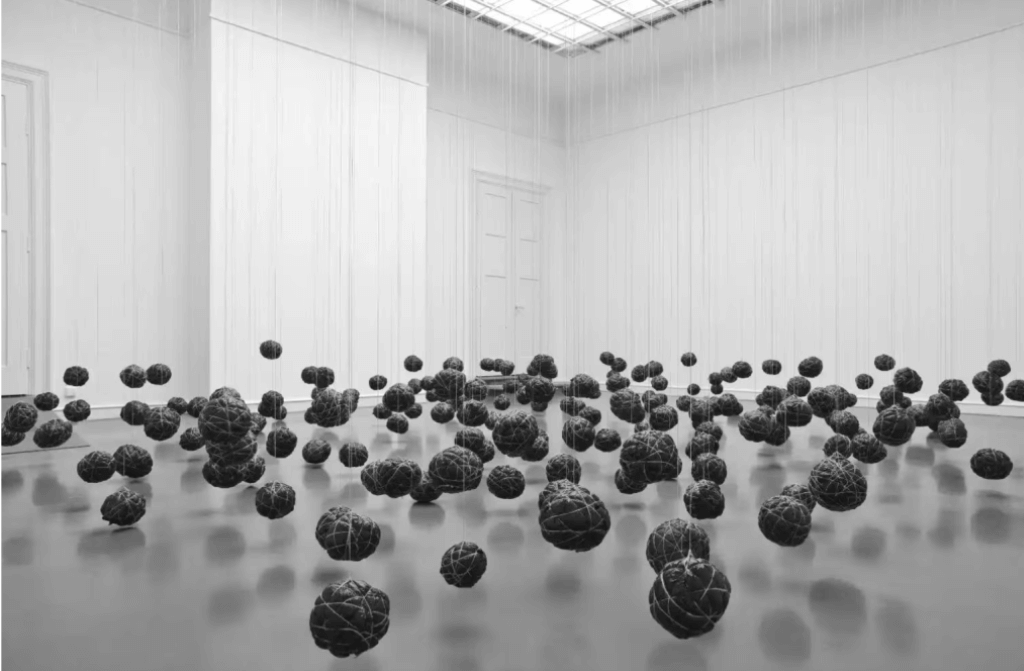From 10 June to 14 September 2025 , the Galleria Borghese hosts, for the first time in the residence of Cardinal Scipione, an exhibition by the Kenyan and American artist Wangechi Mutu, entitled Poems from the Black Earth , curated by Cloé Perrone. The project, which also starts, like the recently concluded exhibition on the baroque poet Giovan Battista Marino, from the museum’s interest in poetry, is conceived as a site-specific intervention that develops in the internal rooms of the museum, on the façade and in the Secret Gardens, challenges classical tradition, crossing suspensions, fragmented forms and new imagined mythologies, and creates a multilayered dialogue between the artist’s contemporary language and ancient authority.
The title evokes the profound meaning of Mutu’s dual practice , intertwined between poetry and mythologies , yet deeply rooted in contemporary social and material contexts . The “black earth”, rich and malleable in the rain, almost like clay, appears in multiple geographies, including the Secret Gardens of the Galleria Borghese, which offer a point of resonance with the artist’s imagery. From this earth, the sculptures seem to emerge, as if shaped by a primordial force, giving rise to stories, myths, memories and poems. The metaphor underlines the generative and transformative force of his work: rooted in materiality yet open to multiple future interpretations.
Wangechi Mutu’s intervention introduces a new vocabulary into the historical and symbolic architecture of the Galleria Borghese. Through sculpture, installation and moving image, the artist proposes an innovative approach to the museum space, which challenges hierarchy, permanence and fixed meaning. Her works question the visual weight and authority of the collection, adopting strategies of suspension, fluidity and fragmentation. In this way the museum presents itself not as a simple static container of objects, but as a living organism, in continuous transformation , shaped by loss, adaptation and reconfiguration.
The exhibition is divided into two complementary sections. Inside the museum Mutu radically reconsiders the spatial orientation and his sculptures never hide the Borghese collection, but are added lightly . Ethereal presences that hover in the air, fly lightly, or are placed on horizontal planes. Works such as Ndege, Suspended Playtime, First Weeping Head and Second Weeping Head challenge the gravitational logic, hanging delicately from the ceilings and framing new views. This act of suspension is not only formal but suggests a shift in historical narratives and material hierarchies. The visual field of the museum is redrawn and new modes of perception open up to our gaze.
The materials – bronze, wood, feathers, earth, paper, water and wax – are crucial to the ethos of the exhibition. Bronze in particular is stripped of its more traditional meaning to become a vehicle of ancestral memory, recovery and multiplicity. By inserting organic, fluid, mutable substances into a context traditionally dominated by marble, stucco and gilded surfaces, the artist reaffirms the poetics of transformation, of becoming, thus anticipating a theme that will be central to the museum’s 2026 exhibition programme: metamorphoses.
Poems of the Black Earth invites us to transcend fixed perspectives, shifting our gaze to allow multiple narratives to coexist, revealing the museum not only as a space of memory, but as a place of imagination and transformation . Wangechi Mutu’s interventions encourage viewers to inhabit the museum differently, to look not only at what is on display, but also at what has been removed, silenced, or made invisible.
Outside, on the façade of the museum and in the Secret Gardens, unfold: The Seated I and The Seated IV , two modern caryatids created for the façade of the Metropolitan Museum of Art in New York in 2019 as part of the Facade Commission and which testify to an important moment of the artist’s engagement with a public institution; Nyoka, Heads in a Basket, Musa and Water Woman , which reinterpret archetypal vases as spaces of transformation. With The End of eating Everything , Mutu expands his artistic language through video, adding a temporal and immersive dimension to his ongoing exploration of myth. These works give life to new hybrid forms, partly human, partly mythological, partly symbolic containers, drawing on East African traditions and global cosmologies, which seem to emerge from a symbolic terrain. Their poised presence in the gardens and on the façade offers a counterweight to the classical order of the site, challenging idealized form and linear narrative in favor of ambiguity, otherness and spiritual presence. Sound, real or suggested, and its trace also play a subtle but pervasive role in the exhibition: from the suspended rhythm of Poems for my great Grandmother I to the supported text of Grains of Words , taken from the song War by Bob Marley inspired by a key figure of the anti-colonial movements, the last emperor of Ethiopia Haile Selassie (1930-1974), whose 1963 speech at the United Nations called for an end to racial injustice. Language becomes sculptural and sound a form of memory.
The exhibition continues at the American Academy in Rome , where Shavasana I is on display . The bronze figure, lying down and covered with a woven straw mat, is titled after the yoga pose “shavasana” (corpse pose) and is inspired by a real news story. Its placement, in the atrium of the Academy, in the presence of Roman funerary inscriptions, acts as a sounding board for the concept of death, abandonment and the dignity of living.
With this exhibition, the Galleria Borghese continues its commitment to contemporary art, after the exhibitions Gesti Universali by Giuseppe Penone (2023) and Louise Bourgeois. The unconscious of memory (2024), proposing a new way of seeing space, renewed with connections and perspectives through the vision of an important international artist.
The exhibition is made possible thanks to the support of FENDI, official sponsor of the exhibition .

The Seated III,” 2019. Courtesy of The Metropolitan Museum of Art, Photograph by Joseph Coscia, Jr.

Suspended Playtime (2008–2013). Image courtesy of casawi

